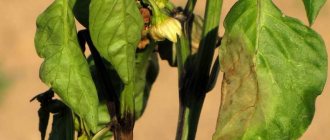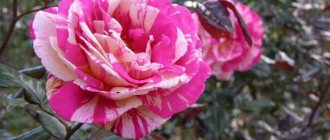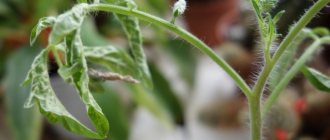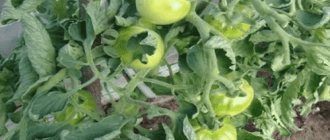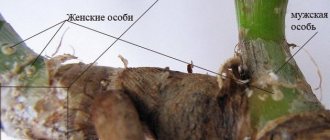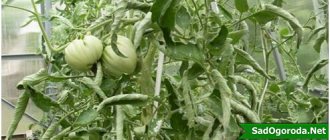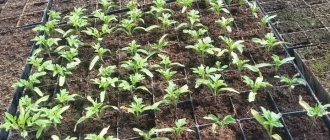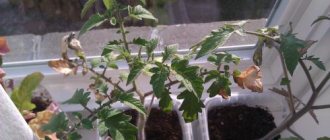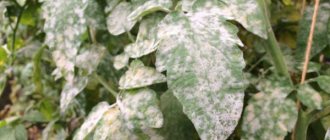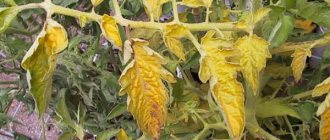Everyone knows that the rose is a gorgeous flower and is rightfully called the “Queen of the Garden.” But unfortunately, we often observe that the leaves of this flower turn yellow.
If this process occurs in the fall, do not worry, this is normal, natural aging and preparation for winter are taking place, the rose sheds its leaves.
You should be wary and pay attention if the rose turns yellow in the summer, when it should bloom and decorate the flower beds.
Next, we’ll look at the reasons why rose leaves turn yellow and fall off: what to do, how to feed and treat the beautiful flower.
Lack of batteries
Yellowing of roses is often associated with a lack of nutrients. The main elements that roses need are:
- Macroelements: nitrogen; potassium; phosphorus.
- Microelements: iron; magnesium; manganese.
If there is a deficiency of one of these basic elements, you can observe: Yellowing of leaves from the edges, completely, in spots.
The site already has an article Feeding roses in spring: how and what is best to fertilize for lush and long-lasting flowering
Lack of macroelements: nitrogen and potassium
| Lack of element | What leaves look like | Signs | How to treat |
| nitrogen | Young leaves become smaller, become pale green, and fall off prematurely. Sometimes red spots appear on them. The stems become bent and weaken. | Use Urea (urea), ammonium nitrate, complex fertilizer: Superphosphate, Potassium Sulfate | |
| potassium | Young leaves are reddish, mature leaves are green with brown, dry edges. The flowers are getting smaller. Potassium deficiency is observed in sandy soils. | Apply complex fertilizer: Superphosphate, potassium sulfate, potassium magnesia, potassium humate | |
| phosphorus | Young leaves become smaller, reddish-purple below, and fall off. The stems bend and weaken. | Apply complex fertilizer: Superphosphate, Potassium sulfate |
Nitrogen
In case of nitrogen deficiency, rose leaves first turn pale, turn completely yellow, and then fall off. Young shoots stop developing. As a rule, the reason for this is planting in nitrogen-poor soil. Immediately you need to carry out nitrogen root feeding.
Important! First, you need to water the rose with clean water.
Nitrogen fertilizing options:
- Urea (carbamide). Prepare an aqueous solution of 2 tbsp. spoons per bucket of water 10 liters.
- Ammonium nitrate (potassium nitrate) .Take 2 tbsp. spoons of fertilizer in a bucket of water. Water 2-3 liters at the root for each bush.
- Cow dung. Infuse 1 kg of manure in 10 liters of water for a week. Dilute 1:10 with water and water 2-3 liters for each flower.
- Bird droppings . Also infuse 1 kg of litter in 10 liters of water for a week, dilute 1:20 and water.
- Green herbal infusion. (2-3 containers of cut nettles and other herbs are filled with water to the brim, left for 7 days, stirring occasionally, watered with a solution of 1 liter of infusion per 10 liters of water.)
Potassium
With a lack of potassium, the lower leaves begin to turn yellow along the edges. The inside of the leaf remains green. Young leaves are reddish in color.
Immediately need to be fed with potassium supplements:
- The simplest potassium supplement is wood ash (potassium + microelements). Pour 2-3 handfuls of ash into the tree trunk circle and loosen the soil.
- Potassium sulfate (potassium sulfate) 2 tbsp. spoons per 10 liters of water or also 2 tbsp. scatter spoons into a circle around the trunk and loosen;
- Potassium nitrate (potassium + nitrogen), feed in a concentration similar to the above;
- Calimagnesia (potassium + magnesium), also 2 tbsp. spoons per 10 liters of water or dry in a circle around the trunk;
- Potassium humate (potassium + microelements), for example, Humate concentration +7 - 1 ampoule per 200 liters of water.
Phosphorus
Phosphorus deficiency manifests itself in redness of the lower leaves. The top ones become small.
Nitrogen and potassium deficiency
Most often, leaves turn yellow precisely due to a lack of nitrogen. To understand this, pay attention to the following signs:
- Mainly the lower leaves turn yellow;
- the upper foliage becomes small and weak;
- the bush produces fewer and fewer new buds.
If all these signs are present, feed the bush with nitrogen-containing fertilizer. Potassium deficiency is most often manifested by the following symptoms:
- leaves turn yellow from the edge to the center;
- sometimes the leaves begin to turn red and then completely turn black.
This problem can be corrected in the same way as nitrogen deficiency by feeding the plant with potassium fertilizer.
Lack of microelements: iron, magnesium, manganese
| Lack of element | What leaves look like | Signs | How to treat |
| magnesium | The middle of the leaf is pale, the tissue dies near the central vein. It appears more on older leaves. Leaves fall prematurely. | Use magnesium sulfate (magnesium sulfate) | |
| iron | It is especially noticeable on young leaves. The leaves turn yellow. reddish, adults - green with brown dried edges. The flowers are getting smaller. Potassium deficiency is observed in sandy soils. | Reduce lime content in the soil. Apply complex fertilizer: Ferovit, you can try iron sulfate. MultiTonic, Toprose | |
| manganese | More noticeable on older leaves. Yellow stripes between the veins on the leaves. | Reduce lime content in the soil. Fertilizer MultiTonic, Manganese sulfate. |
Magnesium
With a lack of magnesium, the middle of the leaf turns yellow, reddish spots appear, and the edges remain green. Yellowing occurs first on the lower old leaves, then rises higher.
It is worth using as a supplement
- magnesium sulfate (magnesium sulfate);
- 2 tbsp. spoons into a bucket of water.
Iron
Often rose leaves turn yellow due to iron deficiency, which leads to chlorosis of the young upper leaves of the flower. The entire leaf turns yellow, the veins remain green. Iron deficiency can be compensated by:
Ferovit 1 ampoule per 1.5 liters of water. Spray.
By the way! Some advise using iron sulfate. At the same time, you will also carry out antimicrobial treatment.
Read more in our article Using iron sulfate in gardening in autumn and spring: when and how to process, instructions for use .
Manganese
Manganese deficiency manifests itself in damage to the lower old leaves, which turn yellow from the edges to the middle of the leaf, while the veins remain green.
Feeding:
- manganese sulfate;
- 2 tbsp. spoons into a bucket of water.
Important! Deficiency of iron and manganese is observed in alkaline soil conditions (pH above 7); it is necessary to bring the soil to a normal and slightly acidic reaction pH of 5-7. This can be achieved by mulching the roses with pine needles or peat.
Waterlogging or drying out of the soil
If the watering regime is incorrect, yellowing and premature loss of rose bush foliage can also occur. If there is too much liquid, the root system of the plant will begin to rot. If there is a lack of moisture, roses simply do not have enough nutrients for normal development and growth.
How often you need to water your roses depends on several factors. Firstly, it is important in what soil the flower grows. Sandy soil requires more frequent watering, clay soil requires less frequent watering. Secondly, the weather is important. The higher the temperature, the more moisture rose bushes require. In cloudy and cool weather, watering should be done as little as possible. To understand whether watering is needed right now, carefully drip the soil 3-5 cm deep and try to squeeze a handful of soil in your hand: if it gathers into a dense lump, there is enough moisture, if it crumbles, it’s time to water.
Improper watering
Roses require moderate watering. Overmoistening of the soil leads to oxygen starvation. The leaves below begin to turn yellow, the entire leaf blade becomes yellow.
Watering should be reduced. And if roses are planted in heavy clay soil, replant them with drier and lighter soil.
Perhaps, on the contrary, your rose does not have enough humidity and watering is insufficient, the leaves turn yellow, curl and fall off.
In this case, you need to increase the frequency and volume of watering and mulch the tree trunk circle to prevent the soil from drying out.
How to properly care for roses
Garden roses are plants that are extremely demanding of proper and high-quality care. To prevent their leaves from turning yellow, you should follow some nuances regarding planting, fertilizing, pruning and covering. In summer, roses are pruned depending on their variety, and in such a way that it is convenient to cover.
Roses should be planted in the fall - you need to choose the timing so that the bush, which has begun to produce young shoots, does not die from the onset of frost. A plant planted too early simply will not have time to establish itself in the soil, and as a result will not be able to survive the winter. After planting, garden roses need to be pruned: remove all weak branches, and leave five to six buds on strong shoots.
Garden roses should be closed immediately after the first frost. Removal of the protective layer is carried out in the spring, in a leisurely manner. As soon as the last layer of snow melts, the southern side is opened slightly, and then, every few days, a third of the material from which the shelter is made is removed. The protection should be removed completely by the time the awakening of the kidneys becomes noticeable.
Roses do not require excessive watering - the liquid is applied relative to the general moisture of the soil in which the bush sits. In spring, the soil is still wet and does not require additional watering. In summer, roses are watered two to three times a month, depending on how dry and warm the weather is. In the autumn season, watering garden roses is reduced or even stopped altogether. Before the bush is covered for the winter, it should be watered using a large amount of moisture.
Black spot
The main symptom is the appearance of spots on both the outer and inner sides of the lower leaves. The leaves turn yellow, dry out and fly off. This is a dangerous fungal disease, the bush loses all its leaves, this leads to weakened immunity and simply freezes in winter.
How to prevent infection?
- Like all fungal diseases, black spot develops rapidly in a humid environment. All spraying should be stopped if the first signs of the disease are noticed.
- It is necessary to clear the tree trunk of fallen leaves, in which fungal spores can live, overwinter and reproduce.
- Important! In spring, roses should be pruned. It is necessary to remove all old and weak shoots. How to do this correctly, read our article Caring for roses in the spring after winter in the open ground: video instructions for pruning, fertilizing and treating against pests
- If flowers are affected by black spot, it is necessary to treat with the following fungicides (drugs against diseases).
For prevention and protection:
- Topaz;
- Bordeaux mixture;
- Oksikhom;
- Home;
- Abiga Peak.
For protection and treatment:
- Speed;
- Profit Gold;
- Ridomil Gold;
- biological preparation - Fitoverm. There is a very informative article on the site Biological insecticide Fitoverm: instructions for use, reviews, when to treat plants and how
Watch the video! How to treat roses for black spot
Important! It is always easier to prevent a disease than to treat it; take preventive measures in time - spraying with antifungal drugs, rather than rushing to treat when all the leaves have already turned yellow and are covered with black spots.
Why do rose leaves turn yellow?
The main reasons why rose leaves turn yellow include all sorts of errors during care, unfavorable climatic influences, various diseases, etc. Most of these problems are not critical - if they occur, you should carefully work with the flower, ensuring it has a long life. life.
Rust
Signs of the disease:
- Orange tubercles appear on the back of the leaf and rapidly increase in size.
- The reverse side of the sheet is covered with a rusty coating.
How to fight rust on roses?
Doing this is quite difficult. Only complete removal of all leaves will help.
- The bushes are treated with copper-containing preparations: Bordeaux mixture;
- copper sulfate;
- biological preparation Fitosporin.
Harmful insects
Each variety of roses differently perceives negative factors that appear due to the appearance of all kinds of insects. A plant that is not resistant is not able to independently resist pests. Crops attacked by insects begin to turn yellow, as small insects suck out cell sap from the shoots, leaves and trunk of the plant.
Pests that attack garden rose bushes include:
- aphid;
- spider mites;
- thrips;
- pink cicada, etc.
Roses that are infested with such pests will begin to suffer: the growth rate will deteriorate, the development of shoots will slow down, the leaves will turn yellow and fall off, and in the end the bush will simply die. To prevent such developments, you should carefully monitor the life of the bush and regularly prevent the occurrence of harmful insects.
If the bush is unlucky and there are already larvae on it, you need to start fighting them. Each insect requires an individual approach, and counteracting them involves spraying and fumigating the plant.
On the shelves of modern specialized stores there are a large number of remedies for a wide variety of pests. However, you can prepare an anti-insect composition with your own hands. For this, a variety of ingredients are used: onions, garlic, red pepper, tobacco, etc.
Diseases of roses that cause yellowing of leaves
| Disease | How the leaves turn yellow | How to treat |
| Black spot | When such a disease appears, the leaves located on the bush begin to become covered with black spots. Yellowed areas form around the dying areas. | The bush should be rid of all leaves affected by the disease. “RIDOMIL” is used as the main means of getting rid of the disease. |
| Purple spot | Purple stripes appear on the leaves of a diseased rose. Such bald spots, after a certain amount of time, begin to gradually lighten. This continues until the leaf turns gray and falls off. | The bush affected by the disease is freed from all diseased leaves. Next, you should use products called “OXYCHOM” or “TOPSIN”. |
| Root cancer | A rose that has contracted bacterial root cancer turns yellow entirely - the color change is noticeable throughout the entire green mass. As the disease progresses, leaf plates begin to fall off, shoots become deformed, and the bush itself dies. | Bacterial root cancer is an extremely complex disease. When it appears, the bush should be dug up, diseased rhizomes should be cut off, and the rest of the system should be treated with a product called “FITOLAVIN”. If the plant is affected excessively, it should be burned. |
| Rot | All leaf blades of a bush that has become infected with rot begin to turn yellow. Spots and bald spots appear on the leaves, and the buds become covered with a light gray or milky coating. | A bush affected by the disease is freed from all diseased leaves. Next, you should use products called “OXYCHOME”, “TRICHODERMIN” or “TOPSIN”. |
Mosaic
A viral disease manifests itself in the appearance of yellowish stains on the leaves.
Is it possible to get rid of mosaic on roses?
- Viral diseases cannot be treated.
- You can do heavy pruning to remove all infected leaves.
- Treat several times with Skor, Ridomil and Strobi.
In any case, if the plant receives sufficient nutrition and looks quite strong, then there is no need to get rid of such a rose yet. Try to save.
Lack of light
Roses are heat-loving plants that should be planted in places with plenty of sunlight. If the plant does not receive direct sunlight, the lower leaves of the bush will begin to turn yellow. A similar problem can be caused not only by an incorrectly chosen location, but also by climatic conditions: extremely cloudy summers.
- Roses planted at the wrong point on the site must be transplanted to more favorable soil - to a sunnier place.
- Roses can survive a cloudy summer if the gardener treats the bush: thins out the crown and treats the bush with a product called Epinom-Extra.
- If the sun's rays do not reach the lower leaves of the bush due to excessively active development of shoots, you should perform high-quality cutting, getting rid of excess vegetation.
When planting roses, you should initially take care of their location: the bushes should be in a sunny place.
Garden beetle
Phyllopertha horticola is a common pest that harms not only roses, but also many fruit and berry crops, as well as lawns.
Signs of damage: it is quite difficult not to notice large beetles with shiny backs, energetically eating the buds and leaves of roses, leaving only the “skeletons” of these parts of the plant.
How to fight? If there are few beetles on the bush, collect them with your hands and destroy them (don’t forget about the larvae). To cope with a large number of pests, use contact insecticides (Inta-Vir, etc.).
Rose pests: how to recognize and fight? We protect roses from dangerous pests.
Reason 6. Pest damage
Causes of yellowing rose leaves.
Black spotting is not a natural process of leaf aging, but an infectious disease that requires treatment. Damage from sucking pests is also a common cause of yellowness on leaves (
Prevention
Why do hosta leaves turn yellow and what to do?
Preventive measures include:
- proper feeding;
- proper organization of watering;
- timely treatment of roses against diseases;
- spraying with insecticides;
- choosing a site for planting taking into account soil characteristics;
- formation of bushes without thickening.
Spraying roses with insecticides
When planning a rose garden at your dacha, you should definitely follow the recommended schemes. Climbing roses are placed every 1.5 meters, bush roses - every 0.5 meters, mini roses - every 30 cm. This is necessary not only for the decorative effect, but also for the prevention of diseases.
When purchasing a rose seedling, you need to study all the features of the variety. There are varieties whose leaves turn yellow in preparation for winter; this is absolutely normal and should not cause alarm.
Growing roses in your summer cottage or at home is a fascinating business; if all the rules are followed and prevention is carried out, it will not create problems and will bring a lot of joy.
0 0 votes
Article rating
Unfavourable conditions
This category includes problems caused by adverse weather conditions and erroneous actions of the gardener.
- Shading . Yellowing of rose leaves often occurs due to the fact that the bushes do not have enough light. This problem is most often encountered when growing bushes indoors. But it happens that an initially unsuccessful place in the garden is chosen for a flower: in the shade of the crown of trees or large shrubs, behind the wall of a fence, house or other buildings. In some cases, the foliage turns yellow only on that part of the bush that is in the shade, or on the lower branches. The latter often happens when the gardener has not been shaping the bush for a long time, which is why it has become overly dense.
- Excess moisture in the soil . Stagnation of water under the rose bush should not be allowed, as this prevents the penetration of oxygen to the root system. Because of this, the roots rot and diseases develop. Excessive humidity also attracts some pests to the rose bush. As a result, the plant weakens, becomes ill, and its leaves begin to turn yellow and fall off. Excessive humidity can be caused by close groundwater, heavy rainfall, and excessive watering.
- Lack of humidity . Despite the fact that waterlogging the soil is detrimental to roses, it cannot grow in dry soil either. If the summer is hot and dry, then the bushes need to be watered quite often and generously, otherwise the plant will not be able to take the required amount of moisture and nutrients from the soil. The leaves will be one of the first to react to this, turning yellow, drying out and starting to fall off.
- Temperature difference . Roses need to be protected from sudden temperature changes. If it's hot during the day and cold at night, they become stressed, which causes the foliage to change color. Some gardeners bring home or greenhouse roses into the garden in the summer. This is also a stressful situation for plants, but over time they adapt to new conditions and recover.
Flower diseases
Garden roses are susceptible to many diseases, both infectious and non-infectious. Let's consider those in which the leaves and shoots turn red.
Infectious burn, or stem cancer
A fungal disease. The pathogen overwinters on the plant itself or in the ground.
Causes and risk factors: warm wintering in conditions with excess humidity, excessive application of nitrogen in the autumn, fungal infection during pruning of roses.
The shoots of a diseased plant are covered with brown spots with redness around the edges. First, damaged areas appear on top. Gradually spread along the entire length of the stem.
Treatment and prevention:
1) Throughout the season, cut out diseased branches with a sterilized instrument;
2) Give nitrogen-containing fertilizers only until July 20;
3) Cover the bushes for the winter in dry weather;
4) When preparing for wintering, tear off and destroy the leaves, treat the rose with copper sulfate or Bordeaux mixture;
5) Open the plant in the spring as early as possible and immediately remove the affected areas of the stems to healthy tissue;
6) After removing the cover, spray with copper sulfate.
Downy mildew
A disease of fungal nature.
Risk factors: heat and moisture, excess nitrogen.
Signs: the visible part of the leaf becomes covered with yellowish-brown and red spots, the leaves curl and fall off.
Poisons do not help get rid of powdery mildew. When the first signs appear, diseased shoots must be immediately removed and destroyed. Treat the remaining ones with iron sulfate or foundation.
- completely dip the purchased bush for a quarter of an hour in a one percent solution of vitriol;
- periodically treat the rose with mullein diluted in water (1 to 10), ash (a glass to a bucket), and weak potassium permanganate;
- spray the bush several times with a soap-soda solution (forty grams of soda and soap per ten liters of water);
- During the season, sprinkle the ground near the plant with ash twice.
Resistant varieties
There are a large number of varieties of roses that are distinguished by strong immunity against pathogenic microflora. Choosing them relieves the gardener of a large layer of worries associated with prevention and treatment. Some of them:
- "Remembrance";
- "Peace"
- "Westerland"
- "Leonardo da Vinci";
- "Golden Wedding"
- "Amber Queen"
- "Scarlet Queen Elizabeth";
- "Glenfiddich"
- "Arthur Bell"
- "Chanelle"
- "Pierre de Ronsard";
- "Beautiful Britain";
- "Golden Celebration";
- "English Miss";
- "Black Magic"
- Fragrant Delight;
- "William Shakespeare 2000";
- "Anisley Dickson";
- "Jubilee Celebration"
- "Fellowship"
- "Augusta Luise";
- "Anne Harkness";
- "Wishing"
- "City of London";
- "Abraham Darby"
- "Double Delight";
- "The Times Rose";
- "Nostalgie"
- "Harvest Fayre"
- "Dame Wendy"
- "Flammentanz"
- "Apricola";
- "Queen Elizabeth";
- "Cherry Girl";
- "Jubile du Prince de Monaco";
- "Golden Years"
- "Aspirin Rose";
- "Margaret Merrill";
- "Crimson Meidiland"
- "Valentine Heart";
- "Escimo";
- "Oranges and Lemons";
- "Toprose";
- "Chippendale"
- "Korresia"
- "Chatsworth"
- "Princess Alexandra of Kent".
rose sawfly
This insect (Arge ochropus) lays eggs by making cuts in the leaves of a rose. It feeds on the pulp of young shoots, as a result of which the stems darken and dry out.
Signs of damage: small pale green caterpillars eat leaves, leaving a translucent “skeleton” after their meal. The plant slows down, becomes deformed, and weakens.
How to fight? Cut off the affected leaves and treat the bush with a contact insecticide (Iskra, Inta-Vir, etc.). For prevention in the fall, dig up the soil under the bushes so that the insects that have settled in for the winter die.
Caring for the rose garden involves a whole range of activities. Give roses enough attention, and they will give you luxurious flowers and an incomparable aroma.
How to feed roses in spring and summer for lush flowering In order for roses to please you not with rare lonely buds, but with abundant long flowering, they need proper care, including timely application of fertilizers.
During flowering
In fact, a rose is a rose hip, only cultivated. It is quite easy to distinguish them from each other. There are, of course, exceptions, but for novice gardeners they are rather informative. During the flowering period, it is very easy to distinguish an ornamental plant from a wild one.
The first flower usually has a lot of petals, while the second has only five. Also, when looking at a rose, you rarely see its middle. There are varieties where it is open on purpose, but they still have a lot of petals. In rose hips, the yellow center is always visible. Rose bush flowers have a huge number of shades of flowers - from white to almost black. Rose hips only have white, pink or hot pink flowers. But there are examples of the opposite.
And such differences are known only to experienced gardeners. To distinguish a wild plant from a noble one, it is enough to look at the differences as a whole.
Burn of rose leaves and branches: description and control of the disease
Burn of leaves and branches of roses is a fungal disease. At first, reddish spots appear on the branches, later darkening in the middle; the red-brown border persists for quite a long time. As the spots grow, they ring the branches. Tissue sagging may form above the affected area. Diseased branches usually dry out in the second half of summer.
The development of “burn” is facilitated by excess humidity under the winter shelter.
To avoid severe damage to roses, cover should be removed earlier in the spring. Diseased and frozen branches must be promptly pruned and burned, and the plants must be sprayed with preparations containing copper, as in the fight against rust.
Proper agricultural technology (timely application of fertilizers, loosening and watering) helps reduce the severity of the disease; it is necessary to ensure good ripening of the wood until the end of the plant growing season.
For the winter, plants should be covered in dry weather if possible in such a way that high humidity is not created under the cover.
Before covering, unripe shoots and leaves are removed, and the plants are sprayed with a 3% Bordeaux mixture or a 1.5% solution of ferrous sulfate.
